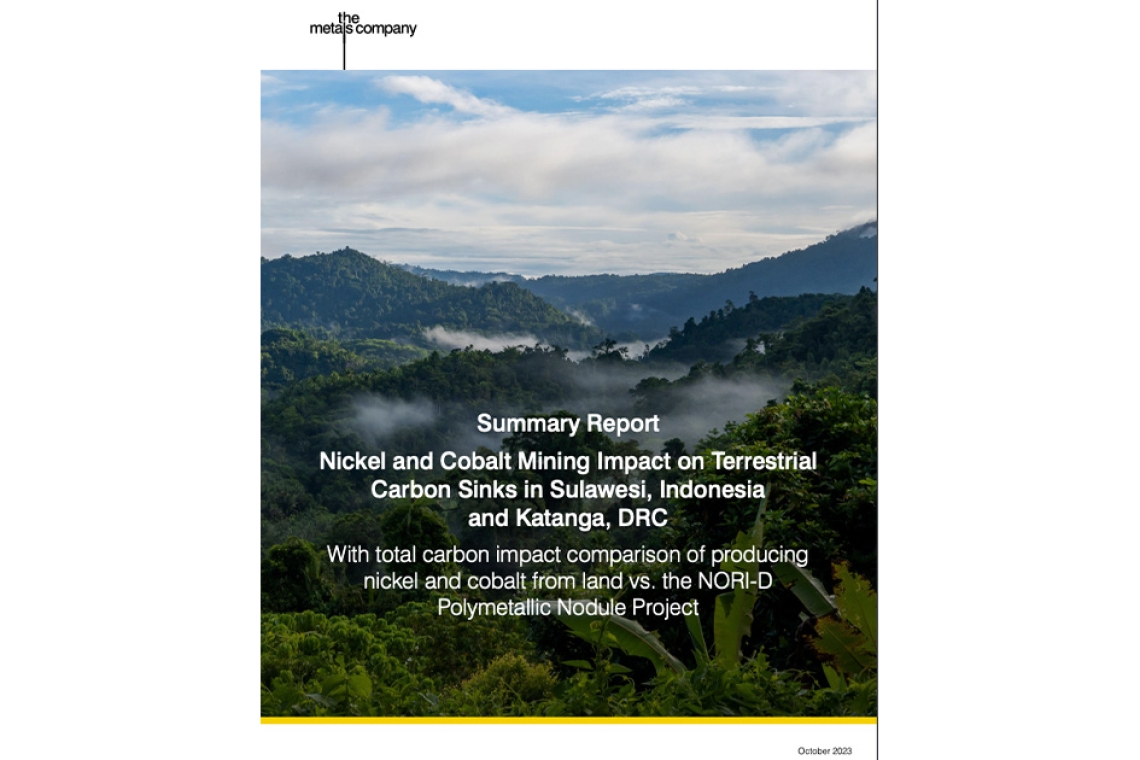New Benchmark Study Highlights Impacts of Nickel and Cobalt Mining on Critical Forested Carbon Sinks Amid Battery Metals Boom

The Metals Company, Inc. (TMC), an explorer of lower-impact battery metals from seafloor polymetallic nodules, announced that leading lithium-ion battery supply chain research firm, Benchmark Mineral Intelligence (“Benchmark”), has completed an independent third-party study of how terrestrial cobalt mining in the woodland forests of the Democratic Republic of Congo (DRC) and nickel mining in the rainforests of Indonesia impact terrestrial carbon sinks.
The full study can be downloaded here and a summary document here.
While awareness is growing of the direct carbon emissions from metals mining and processing, lifecycle assessments do not often assess the impacts of land-use change on carbon sinks in specific regions. The new Benchmark study complements their earlier independent third-party lifecycle assessment where the environmental impacts of TMC’s planned NORI-D Polymetallic Nodule Project are compared to the lifecycle impacts of key-land based production routes for nickel, cobalt and copper. Benchmark focused on DRC (75% of the world’s cobalt production in 2022) and Indonesia (50% of the world’s nickel production in 2022) and set out to quantify the loss of carbon stocks and sequestration services caused by the mining of cobalt in the region of Katanga, DRC and nickel in Sulawesi, Indonesia. Benchmark data was used to select five of the largest mines in each region as case studies, which then underwent Geographical Information System (GIS) mapping analysis to look at changes over a 14-year period. Habitat types were defined using the Land Cover Classification System to assess the changes and impact that mining had on regional carbon stocks during that same period.
"Forest ecosystems play a critical role in the carbon cycle, yet when it comes to sourcing energy transition metals from forested regions, the impacts on carbon stored in trees, plants and soils, and their ability to draw down carbon from the atmosphere unfortunately often go unaccounted for, along with the additional ecosystem services they provide and the loss of biodiversity they host" said Erica Ocampo, Chief Sustainability Officer for The Metals Company.
“This new study provides insights to help us understand the relative benefits of developing the nodule resource in a region devoid of trees or plants, and with orders of magnitude less life than would be found in biodiverse forest ecosystems being impacted by mining today."
In both Indonesia and the DRC, the extraction of metal ores through open pit mines requires the complete removal of overlying ecosystems and contained carbon sinks, in turn eliminating the carbon sequestration services they provide. The study found that 1 kg of nickel mined from saprolite and limonite ore in Sulawesi removes forests containing carbon stock equivalent to 7.0 and 9.4 kg of CO2e, and 3.6 kg of CO2e in the case of cobalt mined in Katanga. Due to the resulting vegetation change, mining activities cause carbon sequestration services loss of 4.8 g and 6.5 g of CO2e respectively for nickel, and 9.3g of CO2e for cobalt per year.
Furthermore, Benchmark reported an average area of vegetation change of 2.6 million square meters and 1.4 million square meters per year respectively for each nickel and cobalt case study mine over the period assessed by GIS. This activity results in the loss of 443,000 tonnes CO2e and 57,000 tonnes CO2e of carbon sinks per year and the annual loss of 309 tonnes CO2e and 147 tonnes CO2e of carbon sequestration services, for nickel and cobalt respectively.
When combining the findings of this latest study on carbon stock loss with the GHG emissions (Global Warming Potential) quantified in Benchmark’s earlier study, the total carbon impacts of Indonesian nickel production from laterites via RKEF and HPAL routes increase by between 7-49% respectively, and by 35% in the case of cobalt production from mixed sulfides in the DRC.
In January 2022, TMC announced the publication of a peer-reviewed study in the Yale Journal of Industrial Ecology which found that seafloor polymetallic nodules could significantly reduce—and in some scenarios eliminate—the onshore solid waste streams typically generated by metal production from land ores. An earlier peer-reviewed study—published in the Journal of Cleaner Production—found that sourcing critical battery metals from seafloor nodules could drastically reduce the lifecycle climate change impacts when compared to land ores.
The Metals Company will convene a webinar on December 12 where Erica Ocampo will discuss the findings of this latest report as well as those of Benchmark’s earlier study.

